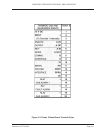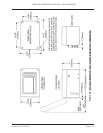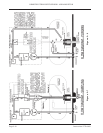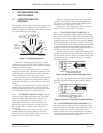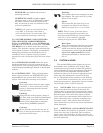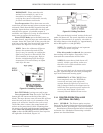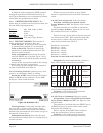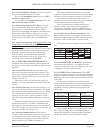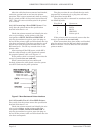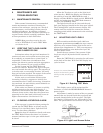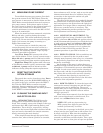
REMOTE INTELLIGENT SENSOR - AREA MONITOR
Page 3-4 Instruction 2772-0803
3.8.3 FAULT RELAY. With the basic system
the single (combined) gas alarm/fault relay is
operated to provide external warning of any of the
monitored ‘fault’ conditions. In a fault condition, the
relay output ‘toggles’ open and closed at 1 Hz. When
the Relay alarm Option is fitted, a separate relay
output is provided which opens and remains open
when a fault is detected. The fault icon and the
relay output remain active until the fault condition
is cleared.
3.9 DIAGNOSTICS
Key system parameters are constantly moni-
tored during normal operation. If any parameters
fall outside acceptable values, a system fault
condition is initiated and the appropriate display
and relay output warnings are given. Each moni-
tored condition, and the icon used on the display in
warning, is detailed in Section 3.7.
3.10 TEST MODE
The TEST Mode is provided to allow users to
quickly check key system parameters. This helps to
ensure the system is always operating in optimum,
trouble-free conditions.
It is recommended that the system parameters
are checked, and recorded, at each cassette change.
Section 2.8.2 explains this and how to use the TEST
Mode. A record sheet is included at the end of the
manual.
3.11 KEYPAD FUNCTION
Use of four keys, and the mode in which each is
active, is as follows:
3.11.1 ‘HOLD/RELEASE’ KEY. This is a toggle.
It is used to hold the displayed data/function for
observation or adjustment. The display ‘holds’ for 5
minutes unless released by a second key press. This
key operates in both Normal and TEST Mode.
3.11.2 ‘PRINT' KEY. This has two functions.
Normal Mode. The key is pressed to download
the data stored in the (optional) printer card
memory to the printer.
TEST Mode. The key is used to clear the
printer card memory (if one is fitted).
3.11.3 ‘15 MIN TWA (DECADE)’ KEY. There are
two functions:
Normal Mode. Operation of the key displays
the TWA for the preceding 15 minutes, (or 10
minutes, if this option is applicable).
TEST Mode. The switch is used to select the
required decade when setting programmable
values (For instance, when changing the alarm
level/s or setting the date/time with the
printer option fitted).
3.11.4 ‘8 HR TWA (DIGIT SET)’ key. Again the
function depends upon the operating mode.
Normal Mode. Pressing the key initiates the
TWA display for the preceding 8 hours.
TEST Mode. The key is used, together with
the decade select key, to select required digit.
3.12 USING THE KEYBOARD
The switches used in the keyboard are of a
rugged sealed membrane type. To ensure positive
operation of the key switches, press firmly.
3.13 OPTIONAL FEATURES
Several optional features are available to extend
the capability of the standard RIS. These options
are:
3.13.1 RELAY ALARM OPTION. This can be
user-retrofitted. The option provides two separate
alarm relay outputs. Each has a user-adjustable set
point. In addition, a separate fault relay is pro-
vided. The option is available for all current RIS
systems with phase 2 base boards and requires the
fitting of an additional circuit board in an already
provided slot.
3.13.2 PRINTER INTERFACE OPTION. Can be
user-retrofitted. The option provides data storage for
up to 7 days of data points, a clock function and
printer control circuitry. When this option board is
fitted, an external printer can be plugged into the
pre-wired port; or hard wired to the system interface.
Option board is fitted into an already provided slot.
The printer circuit board is fitted with DIP
switches to allow selection of the interval at which
data points are printed. Each data point can be
printed as it is calculated, or at intervals from 30
minutes to 24 hours. Printing ‘on demand’, when-
ever the RIS control panel PRINTER key is
pressed is also available.
In addition to the time and value of data
points, a header is printed with TWA’s, system
current and voltage.
3.13.3 TEST CARD. The following shows how to
simulate a gas alarm and enable the operation of
external alarm systems to be checked.




